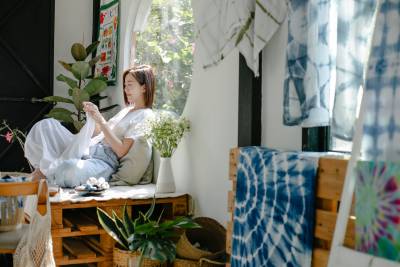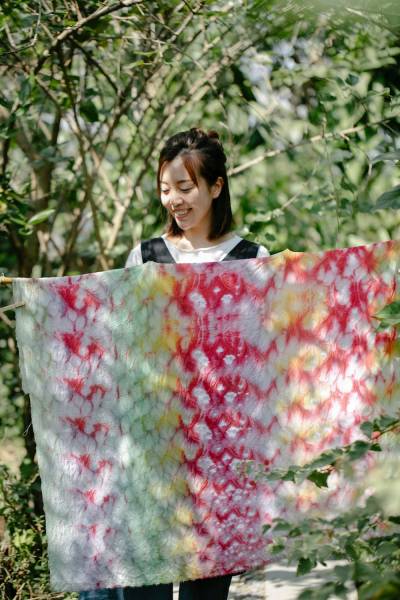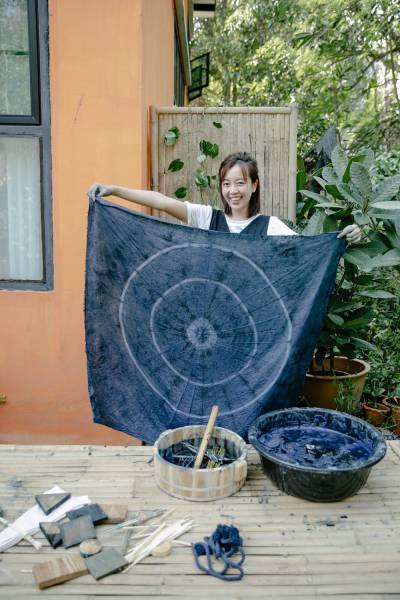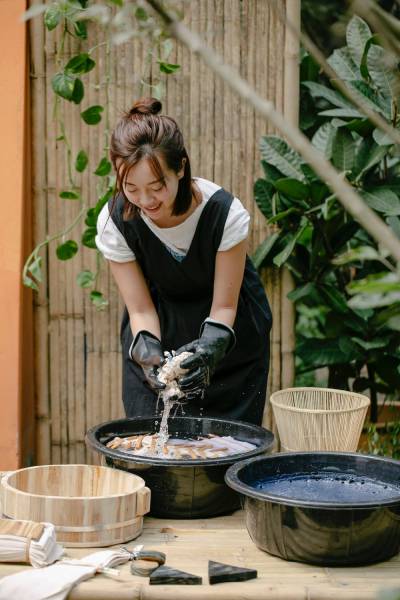Tie Dyeing Fabric: Techniques and Profitable Design Opportunities
Tips and tricks.
Tie Dyeing Fabric: Techniques and Profitable Design Opportunities
Tie Dyeing Fabric: Techniques and Profitable Design Opportunities Are you ready to tap into the vibrant world of tie dye? Whether you're a fashion enthusiast or an aspiring entrepreneur, tie dye is a trend that just keeps on giving. From colorful t-shirts to mesmerizing tapestries, tie dye has captured the hearts of people of all ages and backgrounds. In this guide, we'll dive into the art of tie dye, teaching you how to create stunning patterns that will make heads turn. But it doesn't stop there - we'll also explore the lucrative business potential of tie dye, revealing strategies to maximize your profit while selling your one-of-a-kind creations. So, if you're looking to unleash your creativity, turn heads with your unique fashion sense, and make a splash in the world of entrepreneurship, join us on this colorful journey as we unravel the secrets behind tie dye's timeless allure. Get ready to immerse yourself in a world of vibrant colors and endless possibilities!

The history and resurgence of tie dye

Tie dye has a rich history that dates back centuries. It originated in ancient Asia and Africa, with evidence of tie dyeing techniques found in artifacts from as early as the 6th century. The process involves tying or folding fabric in various ways and then applying dye to create unique and colorful patterns. Tie dye gained popularity in the United States during the 1960s and 1970s as a symbol of the counterculture movement. It was embraced by the hippie generation as a form of self-expression and a rejection of mainstream fashion.
In recent years, tie dye has experienced a resurgence in popularity. It has become a staple in the fashion industry, with designers incorporating tie dye patterns into their collections. Celebrities and influencers have also been spotted wearing tie dye garments, further fueling the trend. The appeal of tie dye lies in its ability to create bold and eye-catching designs, making it a versatile choice for both casual and statement pieces. This resurgence has opened up new opportunities for entrepreneurs to capitalize on the tie dye trend and turn their passion for creativity into a profitable business.
Why tie dye is a profitable business opportunity
Tie dye presents a profitable business opportunity for several reasons. First and foremost, tie dye is in high demand. Its vibrant and unique designs appeal to a wide range of consumers, from fashion-forward individuals looking for something different to those seeking nostalgic pieces reminiscent of the tie dye's heyday. The versatility of tie dye also allows for a wide range of products, including t-shirts, dresses, hoodies, accessories, and home decor items like tapestries and pillow covers.
Furthermore, tie dye has a relatively low cost of entry. The materials needed for tie dyeing are easily accessible and affordable. All you need is fabric, dyes, rubber bands, and some basic equipment. This means that you can start a tie dye business with minimal investment, making it an attractive option for aspiring entrepreneurs on a budget.
Another reason tie dye is a profitable business opportunity is its potential for customization. Customers are drawn to tie dye because it offers them the opportunity to own something truly unique. By offering customization options, such as allowing customers to choose their colors or patterns, you can differentiate your tie dye products from mass-produced alternatives. This personal touch can command higher prices and create a loyal customer base.
Understanding the target market for tie dye garments
To maximize your profit when selling tie dye garments, it's essential to understand your target market. Tie dye appeals to a diverse range of customers, so it's important to define your niche and tailor your products and marketing efforts accordingly.
One target market for tie dye garments is the fashion-forward crowd. These individuals are constantly seeking unique and statement pieces to stand out from the crowd. They appreciate the artistry and craftsmanship behind tie dye and are willing to pay a premium for high-quality, one-of-a-kind garments. When targeting this market, focus on creating intricate tie dye patterns and using premium fabrics to justify higher price points.
Another target market for tie dye garments is the eco-conscious consumer. Tie dye aligns well with the sustainable fashion movement due to its handmade nature and the potential for upcycling old garments. Emphasize the eco-friendly aspects of tie dye in your marketing materials, such as using natural dyes or promoting the use of organic and ethically sourced fabrics. This will attract consumers who prioritize sustainability and are willing to support brands that align with their values.
Lastly, tie dye appeals to the nostalgia-seeking market. These are individuals who grew up during the tie dye's heyday and are looking to relive or rediscover the trend. Capture their attention by offering tie dye designs that evoke the spirit of the '60s and '70s. Consider creating limited edition collections inspired by iconic tie dye patterns from that era. Collaborating with influencers or celebrities who embody the tie dye aesthetic can also help you tap into this market.
By understanding your target market and tailoring your products and marketing efforts to their preferences, you can effectively position your tie dye business for success.
Materials and equipment needed for tie dyeing

To create stunning tie dye garments, you'll need a few essential materials and equipment. Here's a list of what you'll need to get started:
Fabric: Choose natural fibers like cotton or linen for best results. These fabrics absorb dye well and are comfortable to wear. Pre-wash the fabric to remove any chemicals or finishes that may interfere with the dyeing process.
Dyes: There are various types of dyes available for tie dyeing, including fiber reactive dyes, direct dyes, and natural dyes. Fiber reactive dyes are the most popular choice for tie dyeing as they provide vibrant and long-lasting colors. Choose a range of colors to offer your customers a wide selection.
Rubber bands: Rubber bands are essential for creating the characteristic tie dye patterns. They help to secure the fabric and create resist areas that prevent the dye from reaching certain sections.

Plastic squeeze bottles: These bottles are used to mix and dispense the dye onto the fabric. They allow for precise control over the application, ensuring your patterns turn out as desired.
Protective gloves: Dyes can stain your skin, so it's important to wear protective gloves to avoid direct contact with the dye.
Plastic wrap or ziplock bags: These are used to wrap the dyed fabric, allowing the dye to penetrate the fabric and develop vibrant colors during the curing process.
Plastic or metal trays: Trays are useful for containing excess dye and preventing it from spreading onto other surfaces.
Plastic table covers or drop cloths: Tie dyeing can get messy, so it's important to protect your work surfaces. Plastic table covers or drop cloths can easily be cleaned or replaced.
Water source: You'll need access to clean water for rinsing the dyed fabric. A sink or hose is typically sufficient.
Drying racks or clotheslines: After rinsing, the dyed fabric needs to be dried. Drying racks or clotheslines provide ample space for the fabric to air dry without touching other surfaces.
By gathering these materials and equipment, you'll be well-equipped to embark on your tie dyeing journey.
Different tie dye techniques and patterns

Tie dye offers a wide variety of techniques and patterns to explore. Each technique produces unique results, allowing you to offer a diverse range of designs to your customers. Here are some popular tie dye techniques and patterns:
Spiral: The spiral technique involves twisting the fabric into a spiral shape and securing it with rubber bands. The spirals create a mesmerizing pattern reminiscent of a bullseye or sunburst.

Crumple: The crumple technique involves scrunching the fabric into a ball and securing it with rubber bands. This technique creates a random and organic pattern with various color combinations.
Shibori: Shibori is a Japanese tie dyeing technique that produces intricate and repeatable patterns. It involves folding, pleating, and binding the fabric before dyeing. Shibori patterns can range from simple geometric shapes to complex designs.
Ombre: The ombre technique creates a gradient effect, transitioning from one color to another. This can be achieved by gradually diluting the dye or by immersing the fabric in different dye baths.
Dip dye: Dip dyeing involves submerging sections of the fabric into a dye bath, resulting in bold and striking color contrasts. This technique is ideal for creating color-blocking effects or adding pops of color to specific areas.
Ice dye: Ice dyeing involves placing ice on top of the fabric and sprinkling powdered dye over it. As the ice melts, the dye is distributed, creating a watercolor-like effect with unique patterns.
These are just a few examples of the many tie dye techniques and patterns you can experiment with. Don't be afraid to mix and match techniques or create your own signature patterns. The possibilities are endless!
Step-by-step guide to tie dyeing garments
Now that you have an understanding of the materials, equipment, and techniques involved in tie dyeing, let's dive into a step-by-step guide to creating your own tie dye garments. This guide will walk you through the process, from preparing the fabric to finishing touches.
Step 1: Preparing the fabric
Begin by pre-washing the fabric to remove any chemicals or finishes. This will ensure that the fabric is clean and ready to absorb the dye. Follow the fabric's care instructions for the best results.
Step 2: Choosing the technique and pattern
Select the tie dye technique and pattern you want to create. Consider the fabric's size and shape, as well as the desired outcome. Keep in mind that different techniques produce different effects, so choose one that aligns with your vision.
Step 3: Preparing the dye
Prepare the dye according to the manufacturer's instructions. Wear protective gloves to avoid staining your skin. Mix the dye in squeeze bottles, using different bottles for each color.
Step 4: Tying the fabric
Lay the fabric flat on a work surface. Use rubber bands to create the desired pattern. Experiment with different folding, twisting, or scrunching techniques to achieve unique results. The tighter you secure the fabric with rubber bands, the more white areas will be preserved.
Step 5: Applying the dye
Using the squeeze bottles, apply the dye to the fabric. Start with the lightest color and work your way to the darkest. Make sure to saturate the fabric thoroughly, applying the dye to both sides.
Step 6: Curing the dye
Once the fabric is saturated with dye, wrap it in plastic wrap or place it in a ziplock bag to prevent the colors from bleeding onto other areas. Let the fabric sit for at least 6-8 hours to allow the dye to cure and develop vibrant colors. You can leave it overnight for even better results.
Step 7: Rinsing and washing
After the curing time has passed, rinse the fabric under cold water to remove excess dye. Continue rinsing until the water runs clear. Remove the rubber bands and continue rinsing to ensure all the dye is removed. Wash the fabric separately in cold water and mild detergent to remove any remaining dye and to set the colors.

Step 8: Drying and finishing touches
After washing, air dry the fabric on a drying rack or clothesline. Once dry, iron the fabric to remove any wrinkles and give it a polished look. You can also add additional embellishments, such as fabric paint or embroidery, to enhance the design further.
By following these steps, you'll be able to create beautiful tie dye garments that are ready to be sold or worn with pride.
Tips for achieving vibrant and long-lasting tie dye colors
To create tie dye garments that stand out and maintain their vibrancy over time, follow these tips:
Use high-quality dyes: Invest in high-quality dyes that are specifically formulated for tie dyeing. These dyes are more vibrant and offer better colorfastness compared to cheaper alternatives.
Pre-soak the fabric: Before dyeing, pre-soak the fabric in a solution of water and soda ash. This helps the fabric absorb the dye more effectively and enhances color retention.
Saturate the fabric: Ensure that the fabric is thoroughly saturated with dye. This will result in more vibrant colors and prevent patchy or faded areas.
Allow sufficient curing time: Give the dye enough time to cure and develop vibrant colors. The longer you can let the fabric sit, the better the results will be.
Wash with care: When washing tie dye garments, use cold water and mild detergent. Avoid using bleach or harsh chemicals as they can fade the colors. Wash the garments separately to prevent color bleeding.
Avoid direct sunlight: Prolonged exposure to direct sunlight can cause the colors to fade. Store tie dye garments in a cool and dark place when not in use.
Detailed Instructions for Tie Dyeing:
A. Spiral Method:
1. Preparation: Wash and dry the fabric to remove any sizing or residues. Dampen the fabric before starting.
2. Creating the Spiral: - Lay the fabric flat. - Pinch the center of the fabric and twist it into a spiral. - Use rubber bands to secure the spiral shape, creating pie-like sections.
3. Applying Dye: - Choose your desired dye colors and mix according to instructions. - Apply the dye to each section, ensuring saturation. - Place the dyed fabric in a plastic bag and let it sit for 6-8 hours or overnight for the dye to set.
4. Rinsing and Washing: - Rinse the fabric under cold water until the water runs clear. - Remove the rubber bands and unfold the fabric. - Wash the fabric in cold water with mild detergent, rinse, and dry.
B. Crumple Method:
1. Preparation: Prepare the fabric as in the spiral method.
2. Crumpling the Fabric: - Crumple the fabric into a random, compact pile. - Secure the crumpled fabric with rubber bands.
3. Dye Application and Washing: - Apply dye to different sections of the crumpled fabric. - Let the fabric sit in a plastic bag for the dye to set. - Rinse, remove rubber bands, wash, and dry.
C. Accordion Method:
1. Preparation: Prepare the fabric as before.
2. Accordion Folding: - Fold the fabric accordion-style, creating a long, narrow rectangle. - Secure the folded fabric with rubber bands.
3. Dyeing and Finishing: - Apply dye to various sections of the folded fabric. - Allow the dye to set in a plastic bag. - Rinse, remove rubber bands, wash, and dry.
By following these tips, you'll be able to create tie dye garments that are not only visually stunning but also long-lasting.
How to price and package your tie-dyed garments
Pricing your tie-dyed garments appropriately is crucial for maximizing your profit. Consider the following factors when determining your prices:
Cost of materials: Calculate the cost of fabric, dyes, rubber bands, and other materials used in the tie-dye process. This will give you a baseline for your production costs.
Time and labor: Factor in the time and effort you put into creating each garment. Consider the intricacy of the design, the number of colors used, and any additional embellishments or finishing touches.
Unique selling points: If you offer customization options or use premium fabrics, you can justify higher price points. Highlight the unique selling points of your tie-dyed garments in your marketing materials to differentiate your products from mass-produced alternatives.
Market research: Research the prices of similar tie-dye products in your target market. This will give you an idea of the price range that customers are willing to pay.
Profitable Design Opportunities:
Tie dyed garments present numerous opportunities for fashion designers to generate profits:
1. Unique Aesthetic: Tie dyeing allows designers to create one-of-a-kind pieces, attracting customers looking for individualistic and trendy fashion.
2. Customization: Designers can offer personalized tie dye options, allowing customers to choose colors and patterns to match their preferences.
3. Sustainability: Tie dyeing promotes sustainable fashion by rejuvenating old or plain garments, reducing waste and supporting eco-conscious consumers.
4. Craft Markets and Online Stores: Designers can sell tie dyed garments at craft markets, art fairs, or through online platforms. Social media can be leveraged to showcase designs and connect with potential buyers.
5. Workshops and DIY Kits: Hosting tie dye workshops or selling DIY tie dye kits provides an additional revenue stream and engages customers in the creative process.
6. Collaborations: Collaborate with influencers or other artists to create limited-edition tie dyed collections, attracting a wider audience.
Selling tie-dyed garments online and offline
Once you've determined your prices, it's important to package your tie-dyed garments in an appealing and professional manner. Consider using eco-friendly packaging materials, such as recycled paper or biodegradable bags, to align with the sustainable nature of tie dye. Add a personalized touch by including a thank-you note or a small gift with each purchase. This will help create a positive and memorable experience for your customers, encouraging repeat business and word-of-mouth referrals.
Tie dyeing offers fashion designers a versatile and profitable avenue for creativity and entrepreneurship. By mastering various tie dyeing techniques, selecting appropriate fabrics, and leveraging unique marketing strategies, designers can turn tie dyed garments into sought-after fashion statements in both physical and online markets.